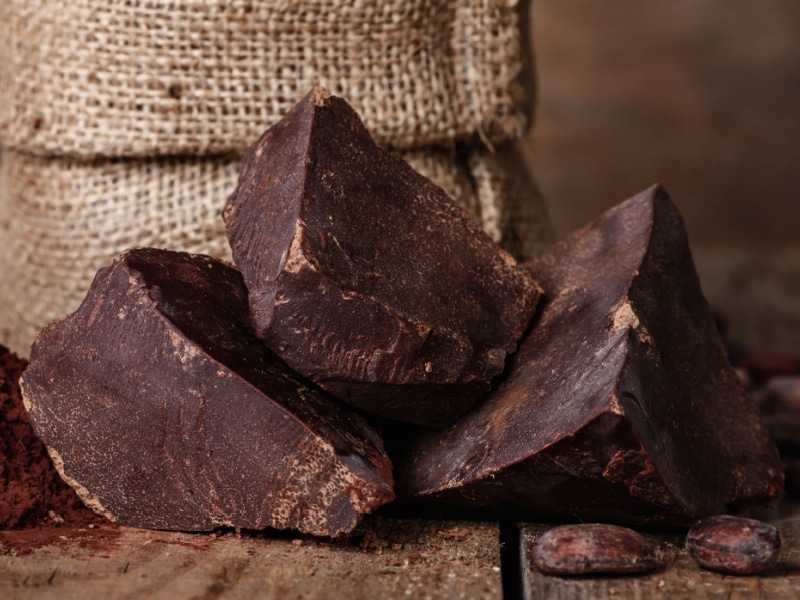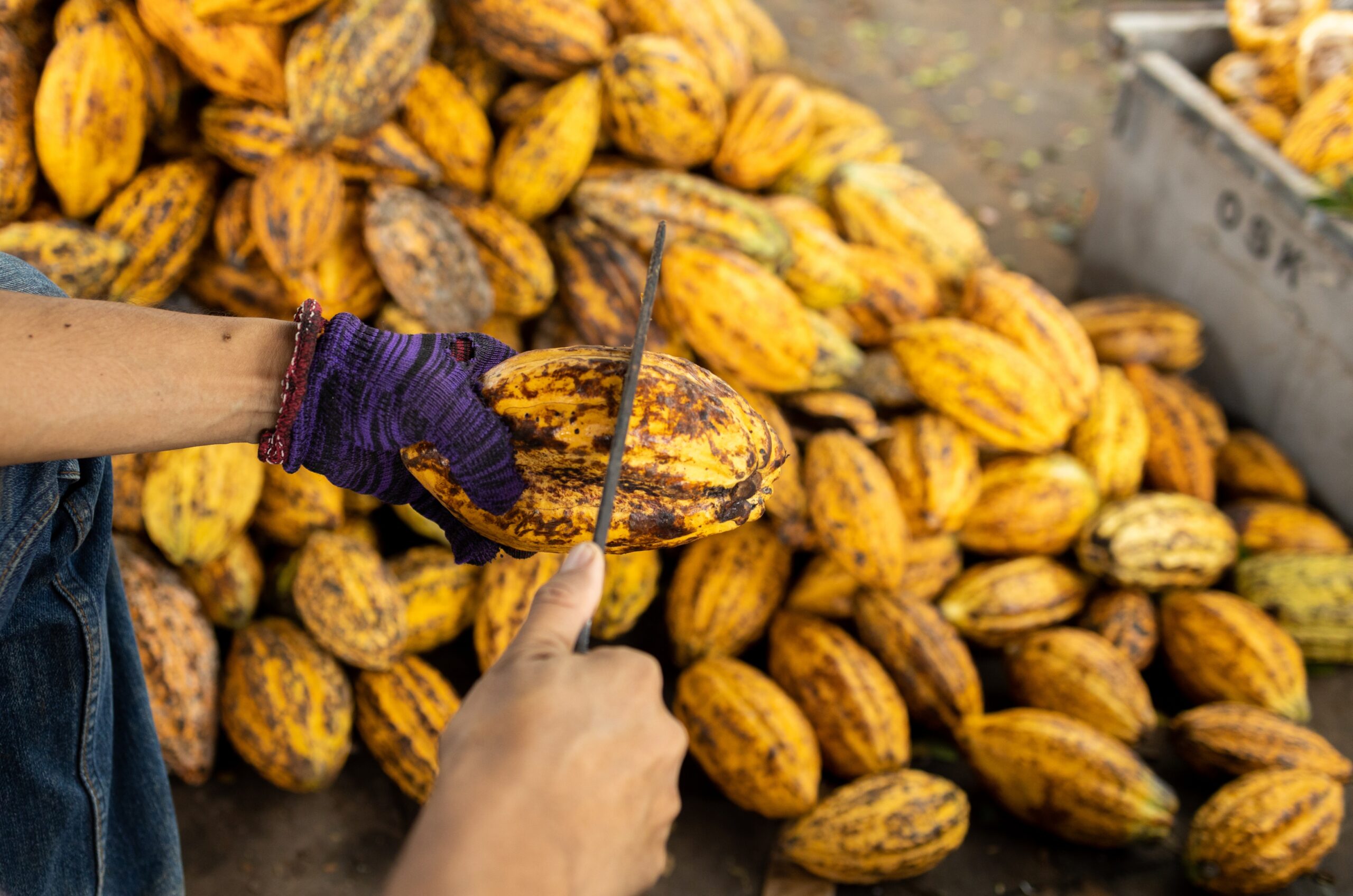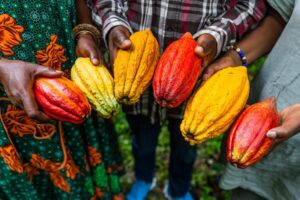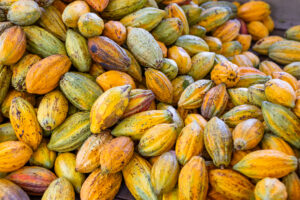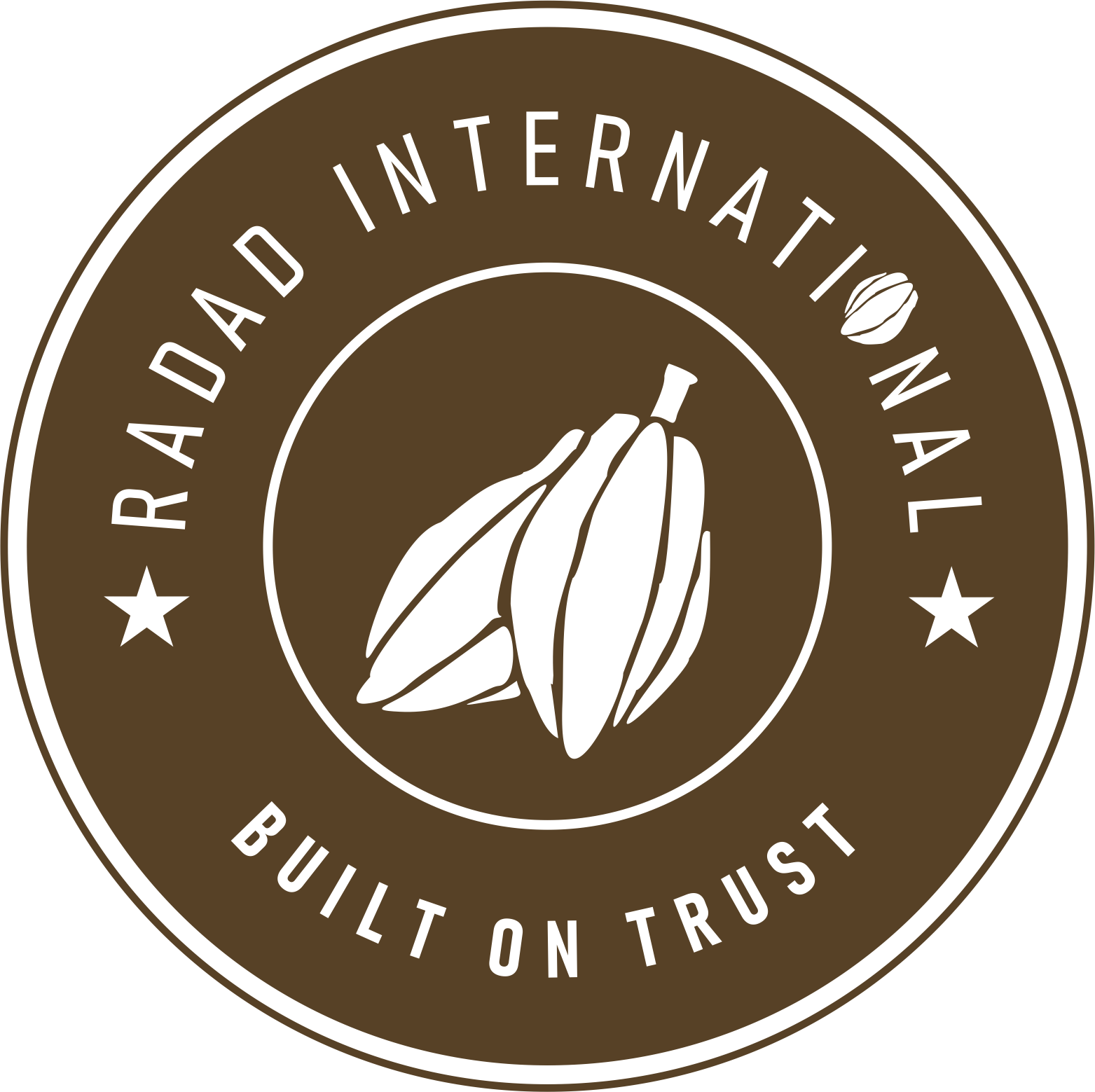Cocoa mass, also known as cocoa liquor, is one of the most vital raw materials in the production of chocolate and other cocoa-based products. It is created by grinding roasted cocoa nibs—the inner part of the cocoa bean—into a dense, smooth paste. This paste contains both cocoa solids and cocoa butter, which are the two essential components in making chocolate.
Despite the term “liquor,” cocoa mass contains no alcohol. The word “liquor” in this context refers to its liquid state at warm temperatures, where the cocoa mass melts into a fluid form. When cooled, it solidifies into blocks or chips and is often referred to as cocoa paste in some manufacturing circles.
Cocoa liquor is a highly concentrated form of cocoa and is used in a wide range of industries:
-
- In the chocolate industry, it forms the base of dark, milk, and even white chocolates (in the case of separating cocoa butter).
-
- In confectionery and bakery products, it contributes to flavor, aroma, and texture.
-
- In cosmetics and nutraceuticals, it’s valued for its antioxidant properties and natural richness.
When it comes to sourcing cocoa liquor in Dubai or the broader UAE region, many manufacturers and resellers look for products that are not only consistent in quality but also sourced from trusted origins, such as West Africa—particularly Ghana, Nigeria, and Ivory Coast—where cocoa beans are known for their high butter content and bold flavor profile.
Composition and Characteristics
Cocoa mass typically consists of:
-
- Cocoa butter: 50%–55% (the fat portion, which gives smoothness and mouthfeel)
-
- Cocoa solids: The part that contains flavor compounds, antioxidants, and color
Its color ranges from deep brown to reddish-brown, depending on the bean origin and roasting profile. The aroma is intense, and the flavor can be slightly bitter, fruity, nutty, or earthy—depending on the cocoa bean variety and fermentation process.
This makes cocoa liquor not just a raw material, but a flavor foundation. Manufacturers often test different cocoa masses from various regions to find the right taste profile for their chocolate lines.
Forms and Packaging
In industrial settings, cocoa mass is usually supplied in:
-
- Solid blocks (typically 25kg or more)
-
- Chips or chunks for easy melting
-
- Liquid form, for facilities with heated storage
When looking for bulk cocoa mass in Dubai, buyers often assess packaging to ensure:
-
- Hygiene standards
-
- Moisture resistance
-
- Proper labeling for origin, batch, and date of production
Packaging is especially important when exporting or importing cocoa liquor to or from the UAE due to the region’s climate sensitivity.
Nutritional Content of Cocoa Mass (Cocoa Liquor)
Key Nutrients Found in Cocoa Mass
1. Healthy Fats
-
Oleic acid (a heart-healthy monounsaturated fat also found in olive oil)
-
Stearic acid (a saturated fat that does not raise LDL cholesterol)
-
Palmitic acid (in smaller quantities)
2. Minerals
-
Magnesium – supports muscle function, energy production, and stress regulation
-
Iron – helps in the formation of red blood cells
-
Zinc – crucial for immune function and skin health
-
Potassium – supports heart and kidney health
-
Copper – involved in iron absorption and cardiovascular health
3. Polyphenols and Antioxidants
-
Reducing oxidative stress
-
Supporting cardiovascular health
-
Improving blood flow and brain function
4. Fiber
-
Digestive health
-
Blood sugar regulation
-
Satiety (feeling full)
5. Mood-Boosting Compounds
-
Phenylethylamine (PEA) – associated with mood elevation
-
Tryptophan – a precursor to serotonin
| Nutrient | Approximate Amount (per 100g) | Health Benefits |
| Calories | 500–600 kcal | Provides energy |
| Total Fat | 50–55 g | Source of healthy fats, including stearic and oleic acid |
| – Saturated Fat | ~30 g | Stearic acid does not raise LDL cholesterol |
| – Monounsaturated Fat | ~15–20 g | Supports heart health |
| Carbohydrates | 10–15 g | Natural sugars and fiber |
| – Dietary Fiber | 10–15 g | Supports digestion and satiety |
| – Sugars | 0–1 g | Naturally low; no added sugar |
| Protein | 10–15 g | Helps build and repair body tissues |
| Magnesium | ~150–170 mg | Supports muscle, nerve, and metabolic function |
| Iron | ~12 mg | Important for red blood cell production |
| Zinc | ~2–3 mg | Boosts immune function and metabolism |
| Potassium | ~500–600 mg | Regulates blood pressure and heart function |
| Copper | ~1–2 mg | Aids in iron metabolism and cardiovascular health |
| Theobromine | ~1–2 g | Mild stimulant, supports mood and alertness |
| Caffeine | ~0.2 g | Natural stimulant in small amounts |
| Flavonoids (Polyphenols) | Rich source | Antioxidants that reduce inflammation and oxidative stress |
| Phenylethylamine (PEA) | Trace amounts | Enhances mood and focus |
Note: Values may vary slightly depending on cocoa origin, processing method, and bean variety.
What Cocoa Mass Does Not Contain
Cocoa Mass vs. Other Cocoa Products: What’s the Difference?
1. Cocoa Mass (Cocoa Liquor)
-
Definition: A thick paste made by grinding roasted cocoa nibs. It contains both cocoa solids and cocoa butter.
-
Form: Paste (when warm), solid blocks or chips (when cooled).
-
Use: Base ingredient for chocolate production.
-
Keyword Note: bulk cocoa mass in Dubai, cocoa liquor supplier UAE
-
Contains: ~50–55% fat (cocoa butter) and ~45% cocoa solids.
2. Cocoa Butter
-
Definition: The fat component separated from cocoa mass during processing.
-
Form: Pale yellow fat, solid at room temperature, melts easily.
-
Use: Gives smoothness and shine to chocolate; also used in cosmetics and pharmaceuticals.
-
Key Traits: No cocoa solids, no chocolate flavor, high in saturated and monounsaturated fats.
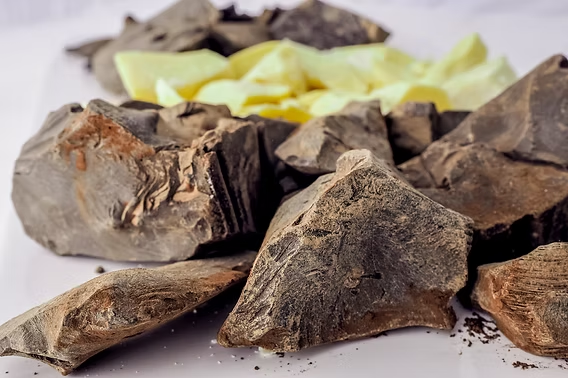
3. Cocoa Powder
-
Definition: The dry, defatted cocoa solids remaining after cocoa butter is extracted from the liquor.
-
Form: Fine brown powder (natural or alkalized/dutch-processed).
-
Use: Baking, beverages (e.g., hot cocoa), and confectionery.
-
Contains: Very little fat (~10–12%), strong chocolate flavor, no cocoa butter.
4. Cocoa Nibs
-
Definition: Crushed bits of fermented, dried, roasted cocoa beans.
-
Form: Crunchy fragments with intense chocolate flavor.
-
Use: Snack foods, baking toppings, inclusion in gourmet chocolate bars.
-
Contains: Natural fat and solids in unprocessed form.
-
Note: Cocoa nibs are the raw material used to make cocoa mass.
5. Chocolate (Finished Product)
-
Definition: A mixture of cocoa mass, cocoa butter, sugar, milk (in milk chocolate), and sometimes emulsifiers.
-
Use: Consumer-end product for eating and retail.
-
Contains: Cocoa mass is the base; cocoa butter, sugar, and other ingredients are added.
Quick Comparison Table
| Product | Cocoa Solids | Cocoa Butter | Flavor Intensity | Common Use |
| Cocoa Mass |  Yes Yes |
 Yes Yes |
Strong | Chocolate production |
| Cocoa Butter |  No No |
 Yes Yes |
Neutral | Texture, cosmetics |
| Cocoa Powder |  Yes Yes |
 No No |
Very strong | Baking, beverages |
| Cocoa Nibs |  Yes Yes |
 Yes Yes |
Raw, bitter | Snacks, inclusion in bars |
| Chocolate |  Yes (in mass) Yes (in mass) |
 Yes Yes |
Sweetened | Final retail product |
Industries That Use Cocoa Mass in Dubai, UAE
1. Chocolate and Confectionery Industry
-
Dark chocolate
-
Milk chocolate (when combined with milk solids and sugar)
-
Gourmet and artisan chocolate lines
2. Baking and Pastry Industry
-
Chocolate glazes
-
Rich chocolate fillings
-
Cakes, brownies, and mousses
3. Nutraceutical and Health Food Industry
-
Protein bars
-
Superfood blends
-
Functional beverages
-
Dietary supplements
4. Cosmetics and Personal Care Industry
-
Chocolate-based spa treatments
-
Natural scrubs and masks
-
Artisan soaps
5. Foodservice and Hospitality Industry
-
Ganache
-
Truffles
-
Chocolate décor and molds
6. Export and Private Label Manufacturing
-
GCC countries
-
Africa
-
Asia
-
Europe
How to Assess Cocoa Mass Quality Before Buying
1. Origin and Bean Variety
-
Flavor profile (fruity, nutty, earthy, bitter)
-
Butter content
-
Color and aroma
2. Fat Content (Cocoa Butter Percentage)
-
The mouthfeel of chocolate
-
Melting behavior
-
Texture in baked goods
3. Moisture Content
-
Shorter shelf life
-
Mould growth
-
Rancidity or flavor spoilage
4. Flavor and Aroma Profile
-
Break a small block and smell it—look for a clean, strong chocolate aroma with no off-notes (like smoke, burnt rubber, or sourness).
-
Taste a sample—pure cocoa mass should be intensely chocolatey, naturally bitter, and full-bodied.
5. Microbiological Safety
-
Salmonella
-
E. coli
-
Mould and yeast
-
Heavy metals
6. Color and Texture
-
A uniform dark brown or reddish-brown color (depending on bean and roast)
-
Smooth texture without graininess or lumps (once melted)
-
No discoloration, white streaks, or powdery residue, which may indicate poor storage or fat bloom.
7. Certifications and Compliance
-
Organic Certified
-
Fair Trade
-
Rainforest Alliance
-
Halal / Kosher
-
EU or FDA Compliance
8. Sample Testing Before Bulk Orders
-
Trial the cocoa mass in your actual product
-
Evaluate flavor consistency
-
Confirm melting behavior and tempering results
-
Check for compatibility with other ingredients
Where to Buy Bulk Cocoa Mass in Dubai, UAE
Trusted Suppliers of Bulk Cocoa Mass in Dubai
Why Choose Radad International?
-
Bulk Supply Capability We cater to both mid-sized businesses and large-scale production facilities, with flexible order volumes and consistent stock availability.
-
Premium Quality, Tested & Verified Our cocoa mass is tested for moisture, fat content, microbiological safety, and flavor consistency before shipping.
-
Direct Sourcing from Africa With boots on the ground in major cocoa-producing regions, we control the supply chain from farm to factory—ensuring transparency and traceability.
-
Export-Ready & Certified Our cocoa mass complies with Halal, Organic, and other regulatory standards, making it suitable for both domestic use and re-export.
-
Convenient Logistics Based in Dubai with efficient access to major seaports and air cargo routes, we ensure timely delivery throughout the UAE, GCC, Africa, Asia, and Europe.
Available Cocoa Mass Specifications
-
Form: Blocks, chips, or liquid (upon request)
-
Fat Content: 50%–55%
-
Packaging: 25kg food-grade cartons or customized bulk options
-
Origin: Ghana, Nigeria, Ivory Coast
-
Applications: Chocolate manufacturing, baking, confectionery, superfoods, personal care
FAQs About Cocoa Mass (Cocoa Liquor) for Buyers in the UAE
What is cocoa mass (also called cocoa liquor)?
What should I check when buying cocoa mass to ensure good quality?
-
Origin of beans (e.g., West Africa, Ghana, Ivory Coast)
-
Bean count (number of beans per 100g – higher count usually means better quality)
-
Appearance and color (should be dark brown and consistent)
-
Moisture content (should be low to prevent mold)
-
Smell and taste (pleasant cocoa aroma, no off smells)
-
Certifications (ISO, organic, fair trade)
-
Absence of mold or fermentation defects
How is cocoa mass usually supplied in the UAE market?
-
What industries in the UAE use cocoa mass?
-
Chocolate manufacturing (artisanal and commercial)
-
Confectionery and bakery industries
-
Beverage production (e.g., cocoa drinks)
-
Cosmetic and pharmaceutical industries (using cocoa butter derived from mass)
What is alkalized cocoa mass, and should I buy it?
How do I request a sample before buying bulk cocoa mass?
What are typical prices for cocoa mass in the UAE?
How to store cocoa mass properly to maintain quality?
What are the payment and delivery terms commonly used?
-
Payment: Bank transfer (T/T), letters of credit (L/C)
-
Delivery terms: INCOTERMS like FOB (Free on Board), CIF (Cost Insurance Freight) are common. Discuss with suppliers to clarify.
-
Where can I buy bulk cocoa mass in the UAE?
-
Specialized cocoa and chocolate ingredient suppliers like Radad International in Dubai and Sharjah
-
Cocoa exporters with warehouses in Jebel Ali free zone
-
International trading companies with local representation (Radad International)
How to verify the authenticity and certification of cocoa mass suppliers?
-
Check certifications (ISO, HACCP, organic)
-
Request quality analysis reports (COA)
-
Ask for references or client testimonials
-
Inspect physical samples before purchase
Can I get customized cocoa mass (different roast levels or particle sizes)?
Are there any import regulations or quality standards in the UAE for cocoa mass?
Partner With Us
-
Discuss pricing for large quantities
-
Get logistics and delivery timelines
-
Learn more about our sourcing practices and certifications

